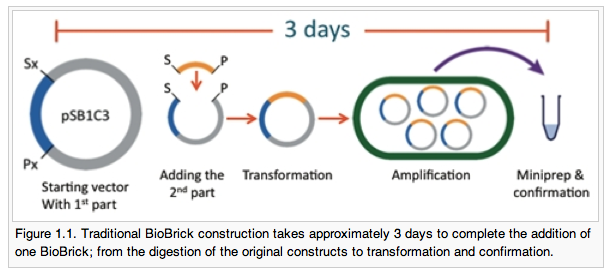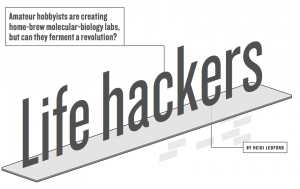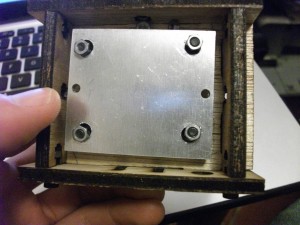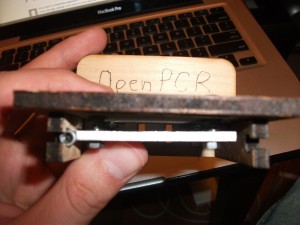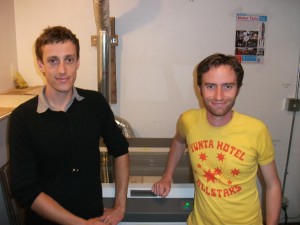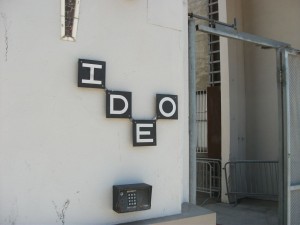iGEM (the international Genetically Engineered Machines Competition) this year consisted of ~130 fantastic teams presenting their summer research over the 3 day competition at MIT. My question for you is, if you’re not at the Jamboree hearing the suggestions of “Check out Harvard’s iGarden”, or “Check out Cambridge reading in the dark by a jug of luminescent bacteria”, how are you supposed to find all the best stuff? My answer is – read this blog.
U.S. Says (Natural) Genes Should Not Be Eligible for Patents
This is interesting:
Reversing a longstanding policy, the federal government said on Fridaythat human and other genes should not be eligible for patents becausethey are part of nature. The new position could have a huge impact onmedicine and on the biotechnology industry.The new position was declared in a friend-of-the-court brief filed bythe Department of Justice late Friday in a case involving two humangenes linked to breast and ovarian cancer.“We acknowledge that this conclusion is contrary to the longstandingpractice of the Patent and Trademark Office, as well as the practice ofthe National Institutes of Health and other government agencies thathave in the past sought and obtained patents for isolated genomic DNA,”the brief said.It is not clear if the position in the legal brief, which appears tohave been the result of discussions among various government agencies,will be put into effect by the Patent Office.If it were, it is likely to draw protests from some biotechnologycompanies that say such patents are vital to the development ofdiagnostic tests, drugs and the emerging field of personalized medicine,in which drugs are tailored for individual patients based on theirgenes.“It’s major when the United States, in a filing, reverses decades ofpolicies on an issue that everyone has been focused on for so long,”said Edward Reines, a patent attorney who represents biotechnologycompanies.The issue of gene patents has long been a controversial and emotionalone. Opponents say that genes are products of nature, not inventions,and should be the common heritage of mankind. They say that locking upbasic genetic information in patents actually impedes medical progress.Proponents say genes isolated from the body are chemicals that aredifferent from those found in the body and therefore are eligible forpatents.The Patent and Trademark Office has sided with the proponents and hasissued thousands of patents on genes of various organisms, including onan estimated 20 percent of human genes.But in its brief, the government said it now believed that the mereisolation of a gene, without further alteration or manipulation, doesnot change its nature.“The chemical structure of native human genes is a product of nature,and it is no less a product of nature when that structure is ‘isolated’from its natural environment than are cotton fibers that have beenseparated from cotton seeds or coal that has been extracted from theearth,” the brief said.However, the government suggested such a change would have limitedimpact on the biotechnology industry because man-made manipulations ofDNA, like methods to create genetically modified crops or genetherapies, could still be patented. Dr. James P. Evans, a professor ofgenetics and medicine at the University of North Carolina, who headed agovernment advisory task force on gene patents, called the government’sbrief “a bit of a landmark, kind of a line in the sand.”He said that although gene patents had been issued for decades, thepatentability of genes had never been examined in court.That changed when the American Civil Liberties Union and the PublicPatent Foundation organized various individuals, medical researchers andsocieties to file a lawsuit challenging patents held by Myriad Geneticsand the University of Utah Research Foundation. The patents cover twogenes, BRCA1 and BRCA2, and the over $3,000 analysis Myriad performs onthe genes to see if women carry mutations that predispose them to breastand ovarian cancers.In a surprise ruling in March, Judge Robert W. Sweet of the UnitedStates District Court in Manhattan ruled the patents invalid. He saidthat genes were important for the information they convey, and in thatsense, an isolated gene was not really different from a gene in thebody. The government said that that ruling prompted it to re-evaluateits policy.Myriad and the University of Utah have appealed.Saying that the questions in the case were “of great importance to thenational economy, to medical science and to the public health,” theJustice Department filed an amicus brief that sided with neither party.While the government took the plaintiffs’ side on the issue of isolatedDNA, it sided with Myriad on patentability of manipulated DNA.Myriad and the plaintiffs did not comment on the government’s brief bydeadline for this article.Mr. Reines, the attorney, who is with the firm of Weil Gotshal & Mangesand is not involved in the main part of the Myriad case, said he thoughtthe Patent Office opposed the new position but was overruled by otheragencies. A hint is that no lawyer from the Patent Office was listed onthe brief.Reversing a longstanding policy, the federal government said on Fridaythat human and other genes should not be eligible for patents becausethey are part of nature. The new position could have a huge impact onmedicine and on the biotechnology industry.
The new position was declared in a friend-of-the-court brief filed bythe Department of Justice late Friday in a case involving two humangenes linked to breast and ovarian cancer.
“We acknowledge that this conclusion is contrary to the longstandingpractice of the Patent and Trademark Office, as well as the practice ofthe National Institutes of Health and other government agencies thathave in the past sought and obtained patents for isolated genomic DNA,”the brief said.
It is not clear if the position in the legal brief, which appears tohave been the result of discussions among various government agencies,will be put into effect by the Patent Office.
If it were, it is likely to draw protests from some biotechnologycompanies that say such patents are vital to the development ofdiagnostic tests, drugs and the emerging field of personalized medicine,in which drugs are tailored for individual patients based on theirgenes.
“It’s major when the United States, in a filing, reverses decades ofpolicies on an issue that everyone has been focused on for so long,”said Edward Reines, a patent attorney who represents biotechnologycompanies.
The issue of gene patents has long been a controversial and emotionalone. Opponents say that genes are products of nature, not inventions,and should be the common heritage of mankind. They say that locking upbasic genetic information in patents actually impedes medical progress.Proponents say genes isolated from the body are chemicals that aredifferent from those found in the body and therefore are eligible forpatents.
The Patent and Trademark Office has sided with the proponents and hasissued thousands of patents on genes of various organisms, including onan estimated 20 percent of human genes.
But in its brief, the government said it now believed that the mereisolation of a gene, without further alteration or manipulation, doesnot change its nature.
“The chemical structure of native human genes is a product of nature,and it is no less a product of nature when that structure is ‘isolated’from its natural environment than are cotton fibers that have beenseparated from cotton seeds or coal that has been extracted from theearth,” the brief said.
However, the government suggested such a change would have limitedimpact on the biotechnology industry because man-made manipulations ofDNA, like methods to create genetically modified crops or genetherapies, could still be patented. Dr. James P. Evans, a professor ofgenetics and medicine at the University of North Carolina, who headed agovernment advisory task force on gene patents, called the government’sbrief “a bit of a landmark, kind of a line in the sand.”
He said that although gene patents had been issued for decades, thepatentability of genes had never been examined in court.
That changed when the American Civil Liberties Union and the PublicPatent Foundation organized various individuals, medical researchers andsocieties to file a lawsuit challenging patents held by Myriad Geneticsand the University of Utah Research Foundation. The patents cover twogenes, BRCA1 and BRCA2, and the over $3,000 analysis Myriad performs onthe genes to see if women carry mutations that predispose them to breastand ovarian cancers.
In a surprise ruling in March, Judge Robert W. Sweet of the UnitedStates District Court in Manhattan ruled the patents invalid. He saidthat genes were important for the information they convey, and in thatsense, an isolated gene was not really different from a gene in thebody. The government said that that ruling prompted it to re-evaluateits policy.
Myriad and the University of Utah have appealed.
Saying that the questions in the case were “of great importance to thenational economy, to medical science and to the public health,” theJustice Department filed an amicus brief that sided with neither party.While the government took the plaintiffs’ side on the issue of isolatedDNA, it sided with Myriad on patentability of manipulated DNA.
Myriad and the plaintiffs did not comment on the government’s brief bydeadline for this article.
Mr. Reines, the attorney, who is with the firm of Weil Gotshal & Mangesand is not involved in the main part of the Myriad case, said he thoughtthe Patent Office opposed the new position but was overruled by otheragencies. A hint is that no lawyer from the Patent Office was listed onthe brief.
Via the New York Times
Read the brief here: Department of Justice Brief on Genes
Disclosure: I am not a good lawyer. Full Disclosure: I am not a lawyer at all. Are you? Chime in!
Great design (for a PCR machine or anything!)
Hi all,
We get a lot of wonderful comments from all of you on the OpenPCR blog. I wanted to highlight one recent post that I really liked. Tom Benedict posted the following rules of thumb on our Dieter Rams 10 Principles for Good Design post:
- Good design uses as much commercial off-the-shelf as possible. (e.g.
don’t re-invent the screw standard if you can use screws from the
hardware store or McMaster Carr.)
- Good design provides for “getatability” of the parts. This term was lifted from an article in American Machinist from the early 1900′s. (Corollary – If you design one part to be almost impossible to get to, chances are it’s the part that will break first.)
- Good design assumes the thing will have to be taken apart. (e.g. If
the faceplate of an electronics enclosure has all the lights, switches,
buttons, and knobs, and the electronics themselves are bolted to another
part of the enclosure, provide connectors so the two parts can be
separated when the enclosure is taken apart.)
- Good design follows function. (e.g. If the thing being designed needs
to be able to be stacked, don’t make it shaped like an Airstream
trailer.)
- Good design maximizes bulk purchasing and minimizes spares. (e.g. If
it requires twenty push button switches, use the same push button switch
in every case. You reduce costs through bulk purchasing, and only need
one or two spare switches to cover every switch on the device.)
- Good design is easy to make. (e.g. It is POSSIBLE to machine a
90-90-90 sharp inside corner in a block of metal, but it’s a real pain
and will cost a fortune. If a rounded corner will work just as well, use
the rounded corner: it’s easier to make.) Talk to your manufacturer.
They’ll know the tricks for making a design cheap and easy to build.
Thanks, Tom!
Tito
OpenPCR in Nature magazine
Case Study: Rapid iteration with hardware
From Eric Reis’ blog, written by Ronald Mannak. (Thanks to Josh Perfetto and Matt Bertram for recommending it!). Excerpt:
The prototypes
The next day we started building the first prototype to see if the sensors actually behaved like they were supposed to, and to see if we could measure the sideway movements. The prototype was crude. Joris taped sensors on his arms with duct tape and started drumming in the air with wooden drum sticks (that did not contain any electronics). We connected the sensors to a seven year old pc with an Arduino-like interface that ran a simple drum program we developed. The results were amazing. It actually worked.
https://www.startuplessonslearned.com/2010/10/case-study-rapid-iteration-with.html
There is certainly a lack of good information on the business of hardware. Hardware sometimes feels like a dark art compared to Software where you can supposedly RentACoder at the drop of a hat, and oh just AB test your way to being a billionaire.
Got a favorite hardware blog? Give them a shout out here, I would love to hear about them.
Tito
The heated lid
Hi rock stars,
Many thanks to the thoughtful, smart suggestions in Name that component!, from Kyle, David, AdamT, Kyle@otyp, and Ben. All together, we worked through the panini/linkage idea, browsed camera shops to find ball joints, and really set out to get the best design that’s easy to build. That said, it can be impossible to find off the shelf parts to bring a new design to reality. More specifically, I’ll say that my current source for searching (McMasterCarr) has lots of really *big* things, lots of door hinges or refrigerator hinges, but not so much in the *small* side of things. Is there a good source for electronics-sized components that you like? Digikey and Mouser stick to electronics components, what I’m wondering about is a digikey+mcmaster love child. Of course, this will be helped in the near future with the rise of 3D printing and Makerbots, where small batches of custom parts start to make sense. Maybe a Makerbot is in my future.
The best design turned out to be the most simple one, suggested by AdamT — 4 springs pushing down the aluminum plate, the whole assembly floats on 4 bolts. The lid gets locked down into a low position, and the springs/hinge float around as needed. I prototyped it up, showed Josh, and we like it. We’re going to be mounting a heater and really testing it out over the next few weeks.
2 opportunities for improvement are:
- how to lock the lid in the “down” position (magnets would be great, a bolt with a thumb screw is more realistic).
- Secondly, the nuts/bolts in the picture are metal and heat up a lot. I’m planning onfinding nylon screws (M3), though their operating temperature is 85C (the lid is heated at 100C to 110C, the melting point of nylon is over double that). Suggestions welcome :)
(Skinny shoulder screws/binding barrels would be nice so that the plate can slide easily up and down except I need 2 nuts on each bolt, one nut to hold the bolt in place at its base, the other nut to keep the aluminum plate/spring on. A bolt with threads at the beginning and end but not the middle would be good.)
Thank you to everyone!
Tito
Re: Treat your machine/pcb/acrylic/laser shop professionally
Update: 9/25/2010 to https://openpcr.org/2010/07/treat-your-machine-shop-professionally/
Good comment from mo – spread the love around. I want to point out that the relationship with your machine/PCB/acrylic/wood shop can be challenging! It’s important but not necessarily easy!
If you can’t meet in person it’s tougher to build repertoire over email or telephone, no matter how charismatic you are. And though I’m usually close to my email, people in shops are on tools and machines most of the time. A phone call is a lot quicker and more personal, but conversations on the phone often lead to miscommunications and frustration. What’s worked for me is talking on the phone, and then summarizing in a follow-up email immediately afterwards. Other points of friction I’ve found are in file formats (I was in Bangalore, India, bouncing between coffee shops and I just couldn’t get the right program in order) and computer use (for instance a shop that insists on printed 2D drawings of a nice 3D CAD file you struggled to put together…), and one guy that always returned calls around a week later.
Experience says: lavishly praise shops you come across when everything goes smoothly.
Right now: I’m working with a shop called OharaRP (out of Dayton, Ohio) on a PCB board and they kick ass!
Tito
OpenPCR goes to Washington
We’re delighted to tell you that OpenPCR has been featured as a highlight of the advances in biotechnology as part of President Obama’s “Presidential Commission for the Study of Bioethical Issues”. Congrats to Jason Bobe, co-founder of DIYbio on the great presentation to our new friends in Washington.
How did OpenPCR make it to Washington? We got a note a few weeks ago from Jason Bobe, founder of DIYbio about his presentation to the Bioethics commission. Could we get a OpenPCR demo out to him to show off while talking about the latest and greatest in biotech? Of course!
I rushed a request Ponoko and explained that we needed another prototype case cut really quickly. They had it cut the next morning, what a great team! I drove over to Oakland to pick up the laser cut case and got a cool tour of Ponoko and met Dan and Josh in person.
Later in the day I made a trip over to IDEO to meet with an industrial designer there. Got some great feedback and a cool tour!
OpenPCR, the Pearl Gel Box, and other great projects start around 35 min in! (Link: Session 6: Current Advances and Practices)
Tito
Name that component!
Welcome to an exciting round of “name that component”. Here’s your host, Tito!
Hi everybody,
We are working to design our heated lid so that it can adjust to small differences in the size or height of tubes. In PCR, we’re cycling the temperature of a small aluminum block between 50C and 100C. We place a plastic tube in each well of the aluminum block, which contains a liquid DNA sample. Now, if we simply have this setup, we will heat our samples to 100C and they will evaporate and condense in the lid of the tube. This is a problem, which is commonly solved by something called a “heated lid”. The 100 C lid needs to make contact with the caps of the PCR tubes, to prevent condensation of the sample. At this point, we have a flat aluminum plate with a heater mounted to it, and are able to reach 100 C. The issue is having the plate make flat contact with all 16 (4 x 4) tubes in the OpenPCR. I’m looking for some sort of a ball joint that we can mount the plate to so that it will rotate every so slightly (10 degrees would be enough).
Now, I know I’ve seen a part like this in existence, but we have little idea where to find it or what is it called?
I would describe it simple as 2 flat plates with a ball joint in between. The size of the plates should be smaller than 1.5″ square, with a few holes in each plate for mounting. I’ve drawn up a crude illustration to attempt at describing this, and have searched mcmastercarr (“ball socket”) got me the closest, but no cigar.
Here’s some “similar” products to what I have in mind…but looking in the <$10 price range and much smaller: https://www.thorlabs.com/thorProduct.cfm?partNumber=SL20
(car gps mount) https://www.cabelas.com/p-0012344012724a.shtml
https://www.newport.com/RN-Series-Ball-and-Socket-Stages/144558/1033/catalog.aspx
Hope you have ideas in mind!
Tito
